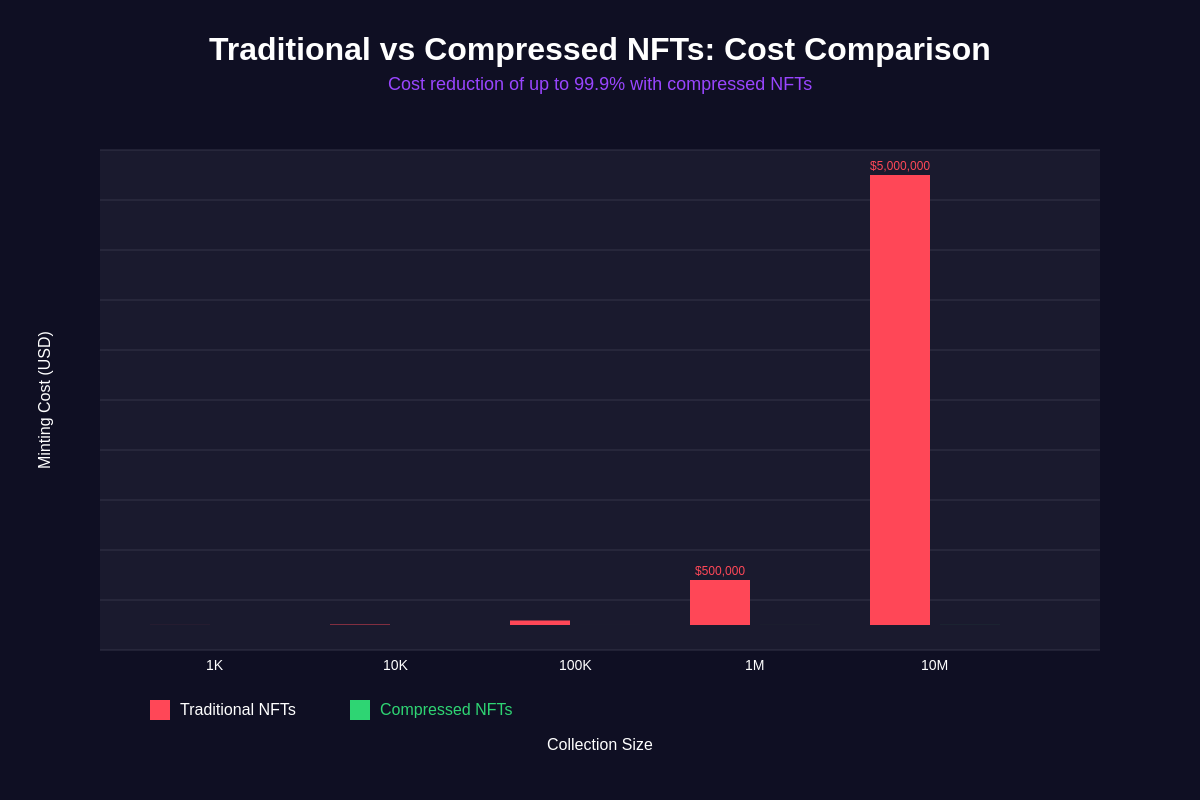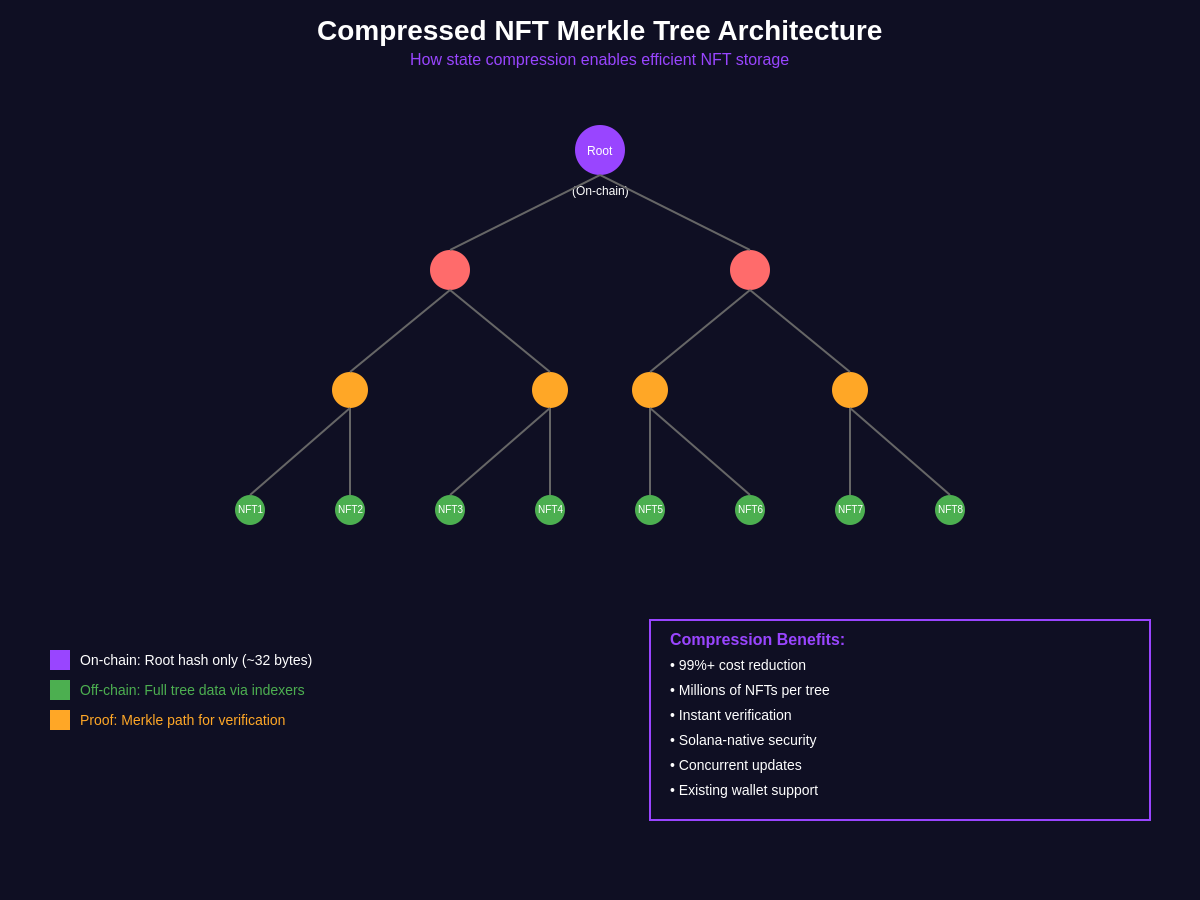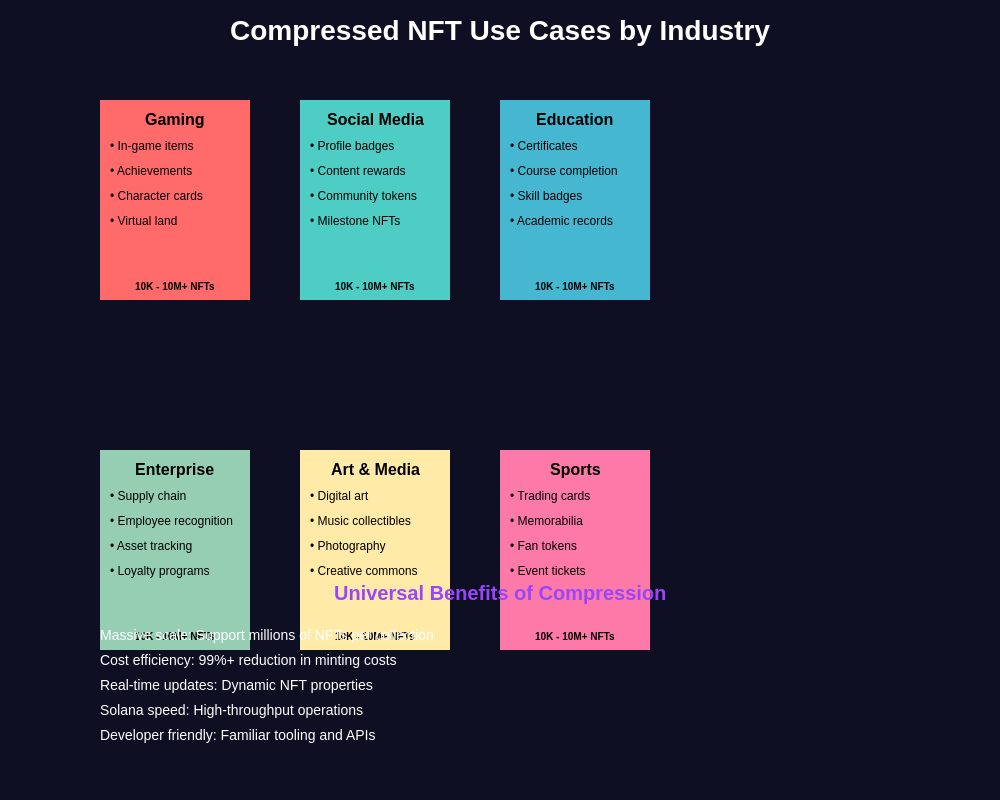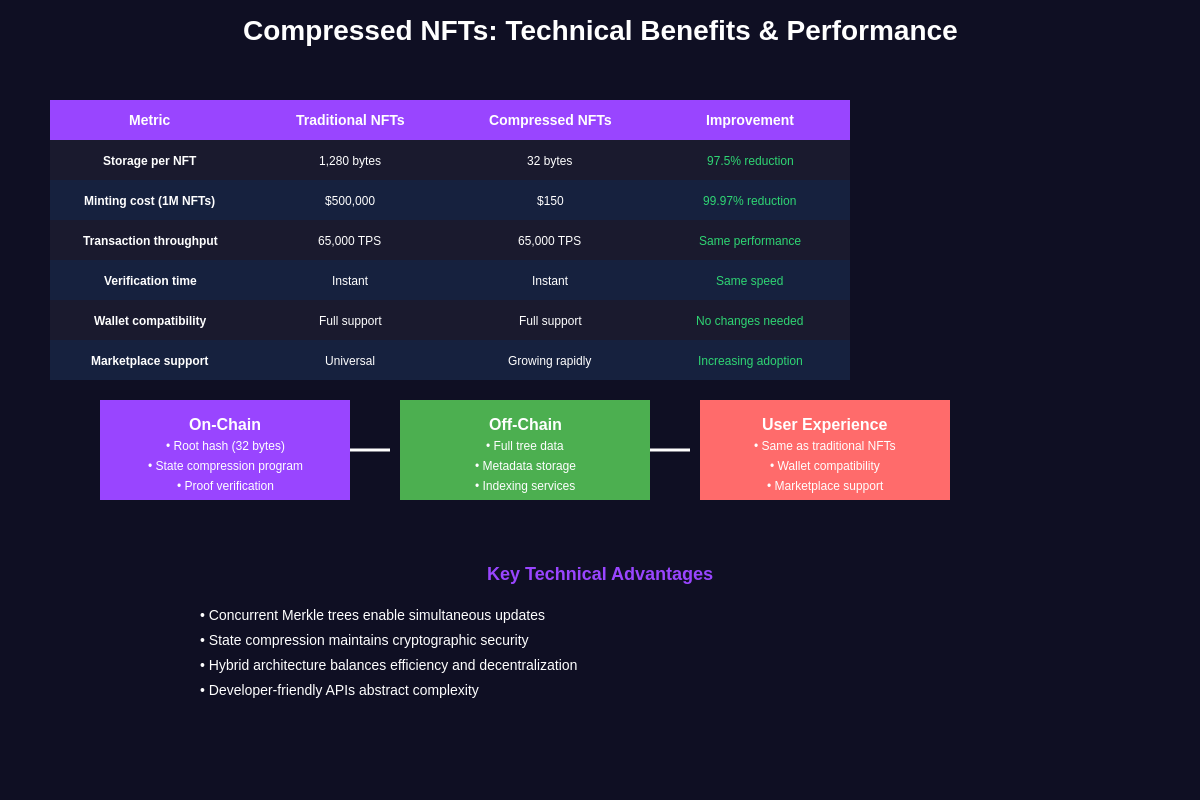The Revolution in NFT Efficiency and Accessibility
The introduction of compressed NFTs on the Solana blockchain represents a groundbreaking advancement in digital collectible technology, fundamentally transforming the economics of NFT creation, distribution, and ownership by reducing costs by over 99% while maintaining the security and authenticity guarantees that make non-fungible tokens valuable. This innovation addresses one of the most significant barriers to widespread NFT adoption: the prohibitively high costs associated with minting large collections or enabling broad participation in digital collectible ecosystems.
Get real-time Solana price data and technical analysis on TradingView to track the network’s performance as compressed NFT adoption accelerates. Traditional NFT implementations on various blockchains have struggled with scalability and cost issues, particularly when dealing with large collections or projects requiring mass distribution, but Solana’s compressed NFT solution leverages advanced cryptographic techniques and the network’s high-performance architecture to solve these fundamental challenges.

The compressed NFT technology builds upon Solana’s existing advantages in transaction speed and low base costs, extending these benefits to NFT operations through innovative use of Merkle trees and state compression techniques that dramatically reduce the on-chain storage requirements for large NFT collections. This approach maintains full compatibility with existing Solana NFT standards while enabling new use cases that were previously economically infeasible, opening doors for educational institutions, gaming platforms, social media applications, and loyalty programs to integrate NFT functionality without prohibitive costs.
Understanding the Technical Foundation of Compression
Compressed NFTs utilize a sophisticated technical architecture that fundamentally reimagines how NFT data is stored and verified on blockchain networks, moving away from the traditional model where each NFT requires individual on-chain storage toward a system that leverages cryptographic proofs to verify ownership and authenticity while storing only essential data structures on-chain. The core innovation lies in the use of concurrent Merkle trees, which allow for efficient batching of NFT operations and dramatic reduction in storage requirements.
The Merkle tree structure serves as a cryptographic commitment to the entire collection, with individual NFTs represented as leaves in the tree and the root hash stored on-chain as a compact representation of the entire collection’s state. When users need to prove ownership or transfer their NFTs, they provide cryptographic proofs that demonstrate their token’s inclusion in the committed tree structure, eliminating the need for individual on-chain accounts for each NFT while maintaining the security guarantees essential for digital ownership.

State compression technology works by storing only the essential state changes and proofs on-chain while maintaining detailed metadata and transaction history off-chain through indexing services and RPC providers. This hybrid approach ensures that all critical ownership and transfer information remains verifiable and immutable while reducing the blockchain storage burden that traditionally made large NFT collections expensive to deploy and maintain.
The technical implementation involves several key components including the State Compression Program, which manages the on-chain Merkle trees and proof verification, specialized indexing infrastructure that maintains off-chain metadata and transaction history, and modified wallet and marketplace software that can construct and verify the cryptographic proofs required for compressed NFT operations. This infrastructure has been carefully designed to maintain compatibility with existing Solana development tools while providing the performance benefits of compression.
Economic Impact and Cost Reduction Analysis
The economic transformation enabled by compressed NFTs represents one of the most significant cost reductions in blockchain technology, with minting costs for large collections dropping from potentially tens of thousands of dollars to mere cents, fundamentally altering the economics of NFT projects and enabling entirely new categories of applications. Traditional NFT minting on most blockchains requires individual transactions and storage allocation for each token, creating linear cost scaling that makes large collections prohibitively expensive for most creators and organizations.
Analyze SOL market trends and trading opportunities as compressed NFT adoption drives increased network activity and developer interest. Compressed NFTs achieve dramatic cost reduction through amortization of storage costs across entire collections, with the marginal cost of additional NFTs approaching zero once the initial tree structure is established, enabling creators to mint millions of NFTs for costs equivalent to what previously would have covered only hundreds of traditional tokens.
The cost structure of compressed NFTs includes initial setup costs for establishing the Merkle tree and compression infrastructure, ongoing indexing and maintenance costs that are typically absorbed by RPC providers or specialized services, and minimal per-transaction costs for transfers and updates that remain consistent regardless of collection size. This cost model particularly benefits large-scale applications such as gaming projects with extensive in-game item collections, educational platforms distributing certificates or achievements, and social media platforms implementing token-based reward systems.
Secondary market implications of compressed NFTs include reduced barriers to entry for collectors and traders, as lower minting costs often translate to more accessible pricing for end users, increased liquidity as creators can afford to experiment with larger and more diverse collections, and enhanced market efficiency as the reduced friction enables more granular and frequent trading activities. The economic accessibility of compressed NFTs has already begun attracting traditional industries exploring blockchain integration, from music and entertainment to retail and enterprise applications.
Developer Adoption and Ecosystem Growth
The developer ecosystem surrounding compressed NFTs has experienced rapid growth since the technology’s introduction, with major NFT marketplaces, wallet providers, and development tools quickly integrating support for compressed collections to capitalize on the technology’s advantages. Leading platforms including Magic Eden, Tensor, and other Solana-native marketplaces have implemented full compressed NFT support, ensuring that creators and collectors can seamlessly interact with compressed collections through familiar interfaces.
Wallet integration has progressed rapidly, with popular Solana wallets such as Phantom, Solflare, and Backpack adding native support for compressed NFT viewing, trading, and management, though the technical complexity of proof generation and verification has required significant updates to wallet infrastructure. Development framework providers including Metaplex, the dominant NFT standard on Solana, have created comprehensive tooling and documentation for compressed NFT implementation, dramatically reducing the technical barriers for creators wanting to deploy compressed collections.
The gaming industry has emerged as a particularly enthusiastic adopter of compressed NFT technology, with blockchain games leveraging the cost efficiency to create extensive in-game item ecosystems that would have been economically impossible with traditional NFT implementations. Projects can now offer thousands of unique items, achievements, and collectibles without the prohibitive costs that previously limited game economies to small numbers of high-value assets.
Enterprise adoption has begun to accelerate as organizations recognize the potential for compressed NFTs to enable previously impossible use cases such as employee recognition programs, customer loyalty systems, and supply chain tracking applications. The ability to mint large quantities of tokens at minimal cost has removed a significant barrier to corporate blockchain adoption, though enterprise implementation often requires additional considerations around compliance, auditability, and integration with existing systems.
Gaming and Interactive Applications
The gaming industry represents one of the most promising applications for compressed NFT technology, as modern games typically require vast inventories of items, characters, achievements, and other digital assets that translate naturally to NFT implementations when cost barriers are removed. Compressed NFTs enable game developers to create comprehensive on-chain economies where every item, from common consumables to legendary equipment, can exist as a verifiable digital asset without the cost constraints that previously limited blockchain gaming to high-value assets only.
In-game economies benefit tremendously from compressed NFT implementation, as players can truly own their digital assets with the ability to trade, sell, or transfer items across compatible games and platforms while developers maintain the ability to create rich, detailed item systems with complex rarity distributions and dynamic properties. The reduced minting costs enable developers to experiment with innovative game mechanics such as procedurally generated items, limited-time events with unique rewards, and complex crafting systems that create new NFTs through gameplay.

Track gaming token performance and market sentiment as compressed NFT gaming adoption continues expanding across the Solana ecosystem. Cross-game interoperability becomes more feasible with compressed NFTs, as the reduced cost barrier enables developers to create shared asset standards and collaborative ecosystems where items earned in one game can be utilized in another, fostering a more interconnected gaming metaverse built on Solana’s high-performance infrastructure.
Social gaming applications have found compressed NFTs particularly valuable for implementing achievement systems, social tokens, and community rewards that would be cost-prohibitive with traditional NFT approaches. Games can now reward players with unique, verifiable achievements for virtually any accomplishment, creating rich progression systems and social proof mechanisms that enhance player engagement and retention.
Social Media and Community Building Applications
Social media platforms and community-focused applications have identified compressed NFTs as a transformative technology for implementing token-based engagement systems, social proof mechanisms, and community rewards that were previously impossible due to cost constraints. Platforms can now offer users unique, verifiable digital collectibles for participation, content creation, milestones achieved, or community contributions without the prohibitive costs that made such systems economically unfeasible with traditional NFT implementations.
Community building applications leverage compressed NFTs to create membership tokens, achievement badges, and social status indicators that provide users with verifiable digital ownership of their social capital and community participation. These tokens can represent everything from early adopter status and content creator achievements to participation in specific events or contributions to community projects, creating rich social economies built on blockchain verification.
Content creator platforms have begun implementing compressed NFT rewards for various forms of engagement, enabling creators to offer unique collectibles to their most dedicated followers, commemorate special events or milestones, and create tiered reward systems that provide increasing value based on supporter participation levels. The low cost of compressed NFTs makes it economical to reward even small interactions, fundamentally changing the economics of creator-fan relationships.
Educational applications represent another significant opportunity, as institutions can issue verifiable certificates, course completion tokens, achievement badges, and other educational credentials as compressed NFTs, creating permanent, transferable records of educational accomplishment that students truly own and can present across different platforms and contexts throughout their careers.
Technical Challenges and Solutions
The implementation of compressed NFTs introduces several technical challenges that developers and ecosystem participants must navigate, including the complexity of proof generation and verification, the need for specialized indexing infrastructure, and the requirement for updated tooling and interfaces that can handle the unique aspects of compressed token operations. Proof generation represents one of the most significant technical hurdles, as users and applications must construct and verify Merkle proofs for every operation involving compressed NFTs.
Indexing infrastructure challenges arise because compressed NFTs store minimal data on-chain, requiring specialized off-chain services to maintain comprehensive metadata, transaction history, and current ownership information that applications need to provide full functionality to users. This creates dependencies on indexing providers and raises questions about decentralization and data availability that the ecosystem continues to address through redundant indexing services and open-source infrastructure development.
Monitor Solana network performance metrics as compressed NFT transaction volume scales and tests network capacity. User experience challenges include wallet complexity as users must understand and manage cryptographic proofs, marketplace integration complexity as platforms must support both traditional and compressed NFT standards, and developer education requirements as building with compressed NFTs requires understanding of advanced cryptographic concepts and specialized tooling.
Solutions to these challenges have emerged through collaborative ecosystem development, including improved developer documentation and educational resources, standardized APIs and SDKs that abstract away much of the complexity for application developers, redundant indexing infrastructure provided by multiple service providers to ensure data availability and resilience, and enhanced user interfaces that hide the technical complexity of proof generation and verification from end users while maintaining full functionality.
Market Adoption and Real-World Applications
Market adoption of compressed NFTs has accelerated rapidly since their introduction, with numerous high-profile projects choosing the technology for new launches and existing projects exploring migration options to take advantage of the cost savings and scalability benefits. Early adopters include major gaming projects, social platforms, and creative communities that require large-scale token distribution capabilities previously impossible with traditional NFT implementations.
Real-world applications have emerged across diverse industries, with retail companies exploring compressed NFTs for loyalty programs and customer engagement, educational institutions implementing blockchain-based credentialing systems, and entertainment companies creating fan engagement platforms that would be cost-prohibitive with traditional NFT technology. The accessibility of compressed NFTs has enabled experimentation with blockchain technology by organizations that previously viewed NFT implementation as too expensive or complex to justify.

Market data indicates that compressed NFT collections consistently achieve higher engagement rates and broader distribution than comparable traditional NFT projects, likely due to the reduced barriers to entry for both creators and collectors that result from dramatically lower costs. This increased accessibility has attracted new participants to the NFT ecosystem who were previously excluded by high minting and transaction costs.
The secondary market for compressed NFTs has developed rapidly, with major marketplaces reporting strong trading volumes and liquidity for compressed collections, though price discovery and valuation mechanisms continue to evolve as the market adapts to the different economics and accessibility characteristics of compressed tokens compared to traditional NFTs.
Regulatory Considerations and Compliance
The regulatory landscape for compressed NFTs involves the same fundamental considerations as traditional NFTs regarding securities law, intellectual property rights, and consumer protection, but introduces additional complexity around the hybrid on-chain and off-chain architecture that regulators are still working to understand and address. The technical architecture of compressed NFTs, which relies heavily on off-chain indexing and metadata storage, raises questions about data sovereignty, auditability, and compliance verification that organizations must carefully consider.
Securities law implications for compressed NFTs generally follow the same frameworks applied to traditional NFTs, with the Howey test and similar analyses determining whether specific compressed NFT implementations constitute securities offerings requiring registration or exemption. However, the lower costs and broader accessibility of compressed NFTs may increase regulatory scrutiny as these characteristics enable wider distribution and potentially different investor dynamics.
Consumer protection considerations include ensuring that users understand the technical dependencies of compressed NFTs, particularly the reliance on off-chain indexing services for full functionality, and the potential risks if these services become unavailable. Clear disclosure about the technical architecture and potential limitations of compressed NFTs becomes particularly important as adoption expands to less technically sophisticated users.
International regulatory coordination becomes increasingly important as compressed NFT applications expand globally, with different jurisdictions taking varying approaches to blockchain technology regulation and organizations operating across multiple regulatory regimes needing to ensure compliance with diverse and sometimes conflicting requirements while maintaining the technical integrity of their compressed NFT implementations.
Future Development and Scaling Potential
The future development trajectory for compressed NFTs includes several promising directions that could further enhance their capabilities and expand their applications, including advanced compression techniques that could achieve even greater efficiency gains, enhanced cross-chain compatibility that would enable compressed NFT functionality across multiple blockchain networks, and improved user experience through better abstraction of technical complexity.
Enhanced programmability represents a significant development opportunity, as current compressed NFT implementations focus primarily on basic ownership and transfer functionality, but future versions could support more complex smart contract interactions, dynamic metadata updates, and sophisticated royalty and licensing mechanisms while maintaining the cost advantages that make compressed NFTs attractive.
Scaling potential for compressed NFTs appears substantial, with theoretical capabilities to handle millions or billions of tokens within single collections while maintaining reasonable performance characteristics, though practical scaling will depend on continued development of indexing infrastructure, proof generation optimization, and ecosystem tooling that can handle the increased complexity of very large compressed collections.
Follow SOL price movements and network adoption metrics as compressed NFT technology continues evolving and expanding across new use cases. Integration with other Solana ecosystem technologies including DeFi protocols, governance systems, and identity solutions could create synergistic effects that further enhance the utility and value proposition of compressed NFTs while contributing to the overall growth and sophistication of the Solana blockchain ecosystem.
Industry Standards and Interoperability
The development of industry standards for compressed NFTs has become increasingly important as adoption grows and different implementations emerge, with the Solana ecosystem working to establish common specifications that ensure interoperability between different platforms, wallets, and applications while maintaining the efficiency benefits that make compressed NFTs valuable. Standard development involves collaboration between major ecosystem participants including Metaplex, leading marketplaces, wallet providers, and application developers.
Interoperability challenges include ensuring that compressed NFTs created on different platforms can be seamlessly transferred and utilized across the ecosystem, establishing common metadata standards that enable rich functionality across diverse applications, and creating standardized APIs that allow developers to build applications that work with compressed NFTs regardless of their specific implementation details.
Cross-platform compatibility efforts focus on enabling compressed NFTs to maintain their functionality when interacting with traditional NFT infrastructure, ensuring that users can seamlessly transition between compressed and traditional NFT environments as needed, and developing bridge technologies that could eventually enable compressed NFT functionality across different blockchain networks beyond Solana.
The evolution toward mature industry standards will likely determine the long-term success and adoption of compressed NFT technology, as standardization reduces development complexity, enhances user experience, and enables the network effects that drive ecosystem growth and innovation in blockchain-based applications.
Economic Models and Creator Monetization
Compressed NFTs have fundamentally altered the economic models available to creators and project developers by dramatically reducing the upfront costs associated with NFT deployment while enabling new monetization strategies based on volume and accessibility rather than scarcity and exclusivity. Creators can now afford to experiment with diverse pricing strategies, larger collections, and more inclusive distribution models that were previously economically impossible.
Revenue sharing and royalty models for compressed NFTs operate similarly to traditional NFTs but benefit from increased transaction volumes and broader market participation that result from lower barriers to entry for collectors and traders. The reduced minting costs enable creators to maintain profitable operations even with lower individual token prices, potentially achieving greater overall revenue through volume-based strategies.
Creator monetization strategies have evolved to take advantage of compressed NFT capabilities, including freemium models where basic tokens are distributed freely to build community engagement while premium versions generate revenue, subscription-based models where ongoing access or updates are tokenized as compressed NFTs, and gamified reward systems that use compressed NFTs to incentivize specific behaviors or participation levels.
The long-term economic impact of compressed NFTs on creator economies remains to be fully realized, but early indicators suggest that the technology could democratize NFT creation and distribution while enabling sustainable business models for creators who previously found traditional NFT economics challenging or inaccessible due to high upfront costs and technical barriers.
Conclusion and Market Outlook
Compressed NFTs represent a transformative advancement in blockchain technology that addresses fundamental scalability and accessibility challenges that have limited broader NFT adoption, offering a solution that maintains the security and ownership guarantees essential to non-fungible tokens while dramatically reducing costs and enabling new categories of applications. The technology’s impact extends beyond simple cost reduction to enable entirely new business models, use cases, and economic relationships between creators, platforms, and users.
The market outlook for compressed NFTs appears highly positive, with continued ecosystem development, growing adoption across diverse industries, and ongoing technical improvements that should further enhance their capabilities and accessibility. As indexing infrastructure matures, development tools improve, and user experience continues to be refined, compressed NFTs are positioned to play a central role in the next phase of blockchain adoption and digital asset integration.
Long-term success will depend on continued innovation in compression techniques, successful resolution of scalability and infrastructure challenges, widespread adoption by major platforms and applications, and regulatory clarity that enables organizations to confidently implement compressed NFT solutions. The technology’s potential to enable blockchain functionality for applications and organizations that previously found traditional NFT implementation too expensive or complex represents a significant expansion opportunity for the broader blockchain ecosystem.
Monitor ongoing Solana ecosystem developments and SOL price performance as compressed NFT adoption continues accelerating and driving innovation across the network. The convergence of reduced costs, enhanced scalability, and maintained security guarantees positions compressed NFTs as a key technology for the next generation of blockchain applications, with implications that extend far beyond digital collectibles to encompass gaming, social media, education, enterprise applications, and entirely new categories of blockchain-enabled services that are just beginning to emerge.
Disclaimer: This article is for informational purposes only and does not constitute financial advice. Cryptocurrency investments carry significant risk, and readers should conduct their own research and consult with qualified financial advisors before making investment decisions. The compressed NFT technology discussed is still evolving, and technical implementations may change. Past performance does not guarantee future results.